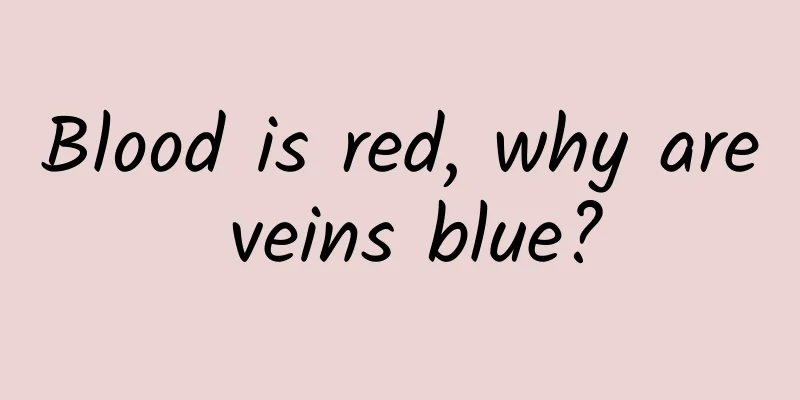Blood is red, why are veins blue?

|
In Europe, "blue blood" was once a symbol of noble status. In the 9th century, Spanish nobles were trying to retake the Iberian Peninsula from the Moors. In the description of historian Robert Lacey, before the battle, the nobles would raise their arms, and the blue veins would be particularly conspicuous against their fair skin. They did this to show that their bloodline was pure and had not been contaminated by the dark-skinned Moors. Initially, this practice may have been to boost morale. The Spaniards at the time probably did not expect that the concept of "noble blood is not red but blue" would spread to the wider world. Because the upper class people did not often expose their skin to the sun, compared with ordinary people who worked outdoors all day and got tanned, the nobles had lighter skin and clearer blue veins. "Blue blood" was once popular throughout Europe to express the difference between the upper and lower classes. We now know that human blood is not usually blue, regardless of status or class. But why do veins in the wrist appear blue? What color is blood? Middle school biology tells us that arterial blood from the heart can transport oxygen to all parts of the body. After releasing oxygen, the blood will flow back to the heart along the veins at all levels. As for the color of arterial blood or venous blood in people's eyes, it is related to the blood circulation process, or to the light reflected and absorbed by the blood during this process. A beam of white light is a mixture of light of different wavelengths, such as red, orange, yellow, green, cyan, blue, and purple. The reason why arterial blood is bright red is that after the hemoglobin combines with oxygen, it can reflect more red light into people's eyes; in contrast, the hemoglobin in venous blood loses some oxygen, absorbs more red light, and reflects less red light , making it difficult to maintain the bright red color of arterial blood. The dark red blood we see when drawing blood is also venous blood. The two tubes above are venous blood (Image source: Wesalius via Wikimedia Commons, CC BY-SA 3.0) More specifically, the part of hemoglobin that determines its color is actually heme . Heme is an iron-containing porphyrin compound. The ring structure centered on the iron atom contains a large number of conjugated double bonds, which allows the molecule to absorb visible light and show a specific color. When oxygen encounters hemoglobin, it must combine with the iron in hemoglobin before it can be transported to other tissues or organs. A hemoglobin molecule can carry up to four oxygen molecules. The wavelength range of light absorbed by hemoglobin varies depending on the number of oxygen molecules combined. Therefore, the color of venous blood with low oxygen content and arterial blood with high oxygen content will be different. But whether bright red or dark red, healthy blood is red, not blue. Where do the blue veins we see come from? What color do you see? Putting a tube of venous blood in front of your eyes and looking at the veins through the skin are two different situations. A beam of white light hitting the skin is different from hitting a transparent glass container. Among the various colors of light that make up white light, the wavelength of red light is approximately between 625-750 nanometers, while the wavelength of blue light is approximately between 450-485 nanometers. Generally, light with a longer wavelength is easier to penetrate the medium. It is not difficult for red light to pass through the skin, but blue light is easily scattered in all directions after entering the skin , making it more difficult to reach deep into the skin. It's like the sun emits light of various wavelengths, but the sky we see is often blue. There are many tiny particles in the atmosphere whose diameters are shorter than the wavelengths of visible light. Both red and blue light will encounter these tiny particles and be scattered, but blue light has a shorter wavelength and is scattered more. This phenomenon is called Rayleigh scattering , and the sky is illuminated by the scattered light, which becomes the blue sky in human eyes. The situation in the skin is similar, with some blue light being bounced back to the eyes before it penetrates the skin . Compared with the easily scattered blue light, a considerable portion of the red light can reach the veins under the skin and take a more complete journey. Of course, both red and blue light may be absorbed in the process of passing through the skin, and both have the opportunity to reach the veins and be absorbed there. The only difference is that different amounts of red and blue light can be reflected back into the eyes. The color of the veins we see is also related to the ratio of red and blue light returning to the eyes. In fact, when white light is irradiated into the vein area, more red light is usually returned than blue light. Therefore, even if observed through the skin, most people should not see blue veins. So how do we think the veins we see are blue? Veins are not drawn on a white piece of paper, there is pink skin around them. Scientists have found that the skin area without veins below reflects little blue light as the vein area, but reflects significantly more red light than the vein area - it looks redder. The veins seen through the skin are not not red, but they may be a little bluer compared to the skin next to them , so they are recognized as blue by the brain. This can be said to be an optical illusion, which is related to color constancy . Color constancy is a characteristic of the human color perception system that allows us to judge the color of objects under different lighting conditions. For example, the picture below simulates the effect of yellow light and blue light shining on the Rubik's Cube respectively. People can easily find the position of the red square from it. Image source: Purves et al., 2016 But when these "red squares" are extracted from their original environment and placed on a white background, people will feel that they are no longer red, but have become orange and purple. In fact, the squares have not changed color, but the result of our recognition has changed. The color of the object we recognize depends not only on the reflected light, but also on the calculation of the brain. In this way, it is not surprising that veins surrounded by ruddy skin are seen as blue. If that color is placed on a white background, we may not think it is blue. The one whose blood turns blue Although human blood is not normally blue, there are some diseases that can turn blood blue. Methemoglobinemia is one such disease. In the blood of healthy people, the iron in hemoglobin is almost all divalent iron (Fe2+), which is responsible for binding oxygen. But in methemoglobin, some iron becomes trivalent iron (Fe3+), which is difficult to bind oxygen. In this hemoglobin molecule, the residual divalent iron ions have an increased affinity for oxygen, making it impossible to release oxygen to tissues normally. Generally speaking, methemoglobin accounts for less than 1% of the blood. If the methemoglobin in the blood exceeds 10%, the human body may experience various symptoms due to lack of oxygen, such as shortness of breath, cyanosis (bluish skin or mucous membranes), mental state changes, headaches, fatigue, etc. When the proportion of methemoglobin in the blood reaches about 70%, humans may be at risk of coma or even death. Dark blue blood (Image source: NEJM) Perhaps the most well-known symptom of patients with this disease is the change in blood color. When the amount of oxygen carried decreases significantly, the blood may appear brown or even blue. In 2019, the New England Journal of Medicine reported a 25-year-old female patient whose blood oxygen saturation was significantly lower than normal, the proportion of methemoglobin was as high as 44% , her blood had turned dark blue, and her skin color had also changed. The patient reported that she had taken a large amount of benzocaine for pain relief the night before she came to the doctor. This may have been the cause of her sudden attack. The next morning, she felt short of breath and weak, and went to the emergency room. After receiving intravenous methylene blue, her breathing improved significantly and the skin discoloration decreased. Eventually, the symptoms completely subsided. Having "noble" blue blood is really not a good thing for humans. |
<<: Do you only know about lotus pods? There are so many delicious things in the water!
Recommend
Eat a little of it every day to nourish your brain, protect your eyes and skin! You can do it in just 2 steps!
As early as the 1940s, people found that the Eski...
How severe was the Martian dust storm that caused the "couple" of fifteen years to say goodbye forever? It blew from Mars to Earth!
Introduction: Have we ever thought that a grain o...
The urgency of video companies’ transformation to OTT can be seen from the low-price sale of Ku6
Recently, the long-established video website Ku6 ...
User Operation: How to create a To B user portrait?
Why do we need to create user portraits? How to c...
AI Internet: Imagine a life without work
Recently, I have discussed a lot about the future...
Taobao's magic tool turns iPhone into dual SIM dual standby, and the actual test is shocking
Everyone knows that the iPhone has no dual SIM ca...
There is a big game behind Youpengpule's 500 million advertising bonus
Recently, Shao Yiding, chairman of China's la...
A brief analysis of the operational strategies at each stage of the AARRR model
The AARRR model can be simply understood as how u...
Explore NVIDIA's leadership in China's high-end ADAS sector
Recently, NVIDIA was ranked the champion of Canal...
How to use channels to achieve user growth?
There are many entrepreneurs around me. Most of t...
If all the seawater on Earth becomes fresh water, will human life be better? The blue planet may no longer have vitality
As we all know, the Earth on which we live is a v...
How much does it cost to rent a server for small and medium-sized enterprises?
How much does it cost to rent a server for small ...
In-depth review: The conversion rate is only 9%, I summarized 6 pitfalls
As one of the proven effective means of attractin...
These 7 trends may be the key to e-commerce user experience design in 2017!
Immersive experience, virtual assistants, persona...









